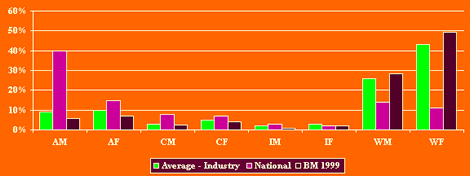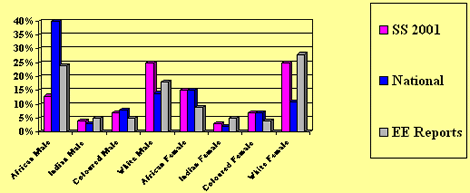12 November 2002
Joe Mjwara, Deputy Director-General: Department of Communications
Refer Appendix 10.4: The state of the advertising and marketing industry in South Africa PDF 152 kb
- Commissioned by the Department of Communications and GCIS
- prepared by Prodigy Business Services cc
"When you have a diverse marketing profession you will see diverse marketing. You will see people asserting themselves. Creativity thrives on diversity. We need more diversity, because in the end it can only benefit us"
- Mpho Makwana (Adfocus: May 24 2002)
The South African advertising industry will be facing the Parliamentary Portfolio Committee on Communications in November 2002, to report on progress that the industry has made in its transformation. Teams of role-players both from government, ad agencies and other private institutions have been formed to look into, the vision for the industry, the regulatory debate around the industry, representativeness in the industry - ownership and employees and advertising spend.
In line with this objective a dipstick survey of advertising and marketing companies was undertaken to examine the state of the industry in terms of its employees and shareholding profile. Results obtained from the survey would be used to assist to determine realistic industry targets in order to achieve equity in the advertising and marketing industries. The survey was conducted in conjunction with the:
- Advertising and Communication Association (ACA)
- Media Forum (AMF)
- Association of Marketers (AoM)
A survey tool was developed in conjunction with the associations mentioned above that sought to answer the research objectives. In addition to the primary research, secondary research was conducted to augment research findings and to close gaps where the primary research failed to provide conclusive insight. Ultimately the research will provide a basis for comparison with future longitudinal tracking initiatives, and provide an overview of the current challenges that face the advertising and marketing industries.
The study conducted has confirmed that the sectors under investigation are still predominantly white owned. Changing legislation, especially with respect to tender requirements has kick started some companies to proactively seek equity partners. Companies that have embraced the equity requirements also have a more representative workforce, however the workforce, especially in the higher ranks is still predominantly white. There is no doubt that progress has been made and an attempt will be made in this report to forecast these trends, in order to test industry targets.
A positive aspect, of the various AA/EE legislation that have been put in place in South Africa, is that of the companies surveyed, 90% of these companies have Human Resource Development and Training policies in place. Affirmative Action polices can be found in all (100%) of the companies that responded to the survey.
The self-imposed ACA target of 40% (PDI overall) has been accepted by most of the companies in these sectors. The ownership profile is reflective of the minimum equity requirements for tenders, viz. 26%. Major suppliers utilised by respondents (>90%) were not aware of the ownership make-up of companies that they procured services to and from. There is a need for companies to actively adapt procurement policies to ensure that procurement is representative of all sectors of the economy. Marketers especially need to ask these questions when procuring goods and services.
The advertising industry is shrouded in controversy with respect to its racist subtext. Each new article explores the same issues and seeks to uncover the truth. Clinical presentations are made to rationalise an emotional issue. The extent of the disparity between black staff and white staff in advertising companies is presented in the graph below.

Figure 1: Employment Profile in the Advertising Industry
The black participation rate in the advertising industry is 32% versus a national average of 75%. The 32%, however represents an increase when compared to the participation rate in 1999 of 22%. Based on these figures, the percentage change in three years has been 10% or 3,33% per year. Given this trend, the advertising sector should reach their self-imposed target of 40% by mid 2004. Equity ownership within the advertising industry has increased, mainly due to the 26% tender requirement. Equity ownership is higher in the subsidiary companies than in the main or holding companies, which suggests that ownership is still protected.
Insufficient information was obtained from media and marketing companies to indicate ownership profiles. The issue with listed companies is that shareholding resides in the form of trusts and other financial instruments that do not reflect a racial identity, thus it is not possible to determine, the equity make-up of these holding instruments. This represents an area that requires additional research, in order to obtain shareholding profiles of listed and non-listed media and marketing companies.
Marketing has had to keep pace with the changing political context of South Africa. The economic demographics of the country are changing, with the implication for marketers that colour ceases to be an issue. Marketing types now need to target consumer types and lifestyle profiles. Marketing has not fared much better than Advertising with respect to transforming the demographic profile of their industry. The high-level industry percentages are presented in the graph below. Participation is still mostly white (50%) and this number increases when the occupational categories, such as senior management are interrogated.

Figure 2: Employment Profile of the Marketing Industry
Thus transformation in the advertising and marketing industries, although present has been slow. There are a number of factors that have impacted on the industries ability to meet transformation requirements and the recommendations below seek to assist in paving the way for accelerated change in the months to come.
Key process recommendations emanating from the research are:
- The research should be segmented into individual sub-industry components in order to obtain the requisite information. The research tool in turn must be structured and specific to prevent respondent fatigue and frustration. Cognisance must be accounted for companies previously providing information via WSPs and EE reports. Attempting to obtain too much information leads to frustration on the part of the respondent, who in turn then does not complete the questionnaire. It is not feasible to ask for Employee demographics and Procurement demographics and Ownership demographics at one go and in a short space of time.
- One also has to ascertain what the requirements of the survey entail. If the survey has as its main purpose to track progress within occupational categories, then industry specific job categories are not required, the EE format can be utilised and compared to year on year information. Adapting the EE reports to provide job specific information, along job categories that have been agreed to by industry stakeholders, will also assist with national skills planning and career planning. Skills priorities can be identified and addressed by employers and educators. Accordingly the SOC/occupational categories provided by DoL require tailoring and the feasibility and applicability or relevance needs to be assessed.
Key Research Gaps that have been highlighted:
- An updated consumer analysis is required to test ad spend per racial grouping. In many instances there is high marketing spend on consumers that are more sophisticated, but not necessarily the biggest consumers.
- A thorough assessment on the constraints and promoters in terms of affirmative procurement should be undertaken through finding out the subcontracting trends in terms of clients (especially the big ad spenders) and government/ parastatals (who are they using - why, the trends in terms of using black companies etc).
- Similarly where companies target black consumers a thorough assessment should be done including who they use in advertisements etc.
Further Research and Insight required for Accelerating Transformation
- The research thus far has focused on input from managers - it is equally necessary to validate the findings through anecdotal evidence from employees - especially black employees.
- An intrinsic understanding of the supply, demand and cycle of equity candidates within these sectors should be undertaken. Why do equity candidates leave the sector, what are the reasons for the shortage of PDI candidates (when the AAA has full classrooms)? Are there particular management practices or sub-cultures that are particularly harmful to PDI candidates?
- An equity and transformation barometer should be an outcome of the research.
The Establishment of Mentorship and Skills Programmes
- It is satisfying to see an emerging black management level within the larger companies. These individuals have to ensure that they constantly seek and remove barriers within the industry and act as mentors to new entrants. Possibly, therefore the findings must be communicated to such managers and a pilot programme established where the feasibility of an equity ambassador programme is discussed.
- Specific management development and new entrant programmes should be established. Synergies should be discussed and established with MAPPP and Services SETAs. Similarly the communication and the business imperative for transformation within the respective sectors must be shared, understood and accepted by the respective SETAs.
- Piloting of specific targeted skills programmes should be initially developed in tandem with industry and with the SETAs and initiated amongst a small pool of progressive companies. Rollout can then occur once the indicators and critical learnings have been established.
Accelerating the Process of Affirmative Procurement
- Procurement policy guidelines need to be ratified and submitted to companies to ensure that transformation impacts all stakeholders.
- Government/Parastatals need to enforce equity requirements as part of good business practice, in their dealings with advertisers and marketers.
- Proactive twinning programmes needs to be examined. Government and parastatals need to be more assertive in their commitment to ensure that the industry does meet and comply with equity standards. The process of mergers and acquisitions between black and white/ international companies will not ultimately ensure the employment and upliftment of the majority of blacks emerging companies. Thus, where an emerging or small black company applies for a tender but is deemed not to have the requisite infrastructure etc, the respective government department or parastatal should then contract the respective black company through a twinning programme.
- The positive work conducted by best practice and informed associations need to be shown off as "success stories" to the industry.
Accelerating Empowerment
-
Transformation of the industry should impact on the masses in the country, those already employed in the industry. The 31% black employees should have an opportunity to participate in their industry. Empowerment should not a boardroom deal with an empowerment company, which impacts only a few.
- In light of the slow progress, especially in the senior levels of the industry, industry and government dialogue should increase and synergies established to implement an action plan for the industry that will seek to identify blockages, redress imbalances but at the same time maintain the competitiveness of the industry as a global player.
- Joe Mjwara, Deputy Director-General: Department of Communications

